 |
August 2015
|
August 2015 // Volume 53 // Number 4 // Feature // v53-4a10
Using Facebook Advertising to Connect with Extension Audiences
Abstract
There is considerable interest in using social media to reach Extension audiences. The study's main objective was to assess the effectiveness of Facebook promotion and event advertising on creating new client contacts as measured by "Likes." The results show the fan base for each county increased slowly prior to and following the Facebook ad, while it increased more rapidly during the advertisement period. Thus, Facebook advertising appears to be an effective tool to increase awareness of Extension Facebook pages. Extension professionals should consider investing in Facebook advertising to expand their fan base.
Introduction
Since 1995, adult use of the Internet has increased from 15% to 87% (Pew Research Center, 2014). Seventy-one percent of online adults use Facebook, with higher rates for younger persons (e.g., 84% of 18-29 year olds) and lower for older persons (e.g., 45% for those 65 and older) (Duggan & Smith, 2014). Facebook is being used for many purposes, including research recruitment (Kapp, Peters, & Oliver, 2013), stakeholder engagement (Waters, Burnett, Lamm, & Lucas, 2009), and outreach (Vucovich, Gordon, Mitchell, & Ennis, 2013). A Florida survey of Extension agents found that word of mouth and online marketing were the two most commonly used forms of program promotion (Telg, Irani, Hurst, & Kistler, 2007) before Facebook became widely used. Advertising on social media sites such as Facebook can supplement Extension's outreach beyond traditional audiences (Kinsey, 2010; Mains, Jenkins-Howard, & Stephenson, 2013).
While Facebook use is proportionately higher among younger age categories (Duggan & Smith, 2014), Extension, especially in Florida, reaches clients who are disproportionately older than the population. For example, the U.S. Census Bureau (2013) reports Florida has 18.7% of its population 65 years or older, while Extension's customer satisfaction data shows a 5-year average of 34.1% who were 65 years or older. Clearly, Facebook and other social media offer hope for expanding participation of younger audiences in Extension programming.
There is a wide variety of strategies for using Facebook to recruit clients, engage them, and build relationships, and an increasing number of studies have focused on the Extension context to show when and how it can be used effectively in the programming process (see Gharis, Bardon, Evans, Hubbard, & Taylor, 2014; Kinsey, 2010; Main et al., 2014; Martinson, Skelly, & Fisher, 2011; Typhina, Bardon, & Gharis, 2015). One notable gap in the literature is whether Facebook advertising stimulates viewers to engage further with Extension. Although Facebook provides many free services, fee-based advertising can be used to "push" information about Extension events and programs to potential clients. Advertisements can lead to immediate outcomes, such as becoming a fan by clicking "Like," and extend to involvement in on-line and off-line educational programming (e.g., traditional seminars, field demonstrations, etc.). When a significant number of the public engage with the county Extension Facebook page as a result of Facebook advertising, it could create a new avenue for direct online learning opportunities for targeted audiences. The main objective of the study reported here was to assess the effectiveness of Facebook advertising on creating new contacts as measured by "Likes." In addition, we evaluated the age and gender of the audiences connecting to Florida Extension via this process.
Methods
Four counties in UF/IFAS Extension's Central District advertised five events on Facebook in 2013: Marion County's Master Gardener Spring Festival, Orange County's EcoNomic Living Expo, Sumter County's Florida Nursery Growers and Landscapers Association and AGRItunity events, and Osceola County's Spring Gardening Series. An event was created on Facebook for each activity, and a series of Facebook ads for the event were delivered for four weeks prior to each event.
The Marion County Master Gardener Spring Festival was a family event providing educational sessions for residents on successful gardening in central Florida. It included over 90 vendors in one location to provide a source of Florida-Friendly plants (see Figure 1).

|
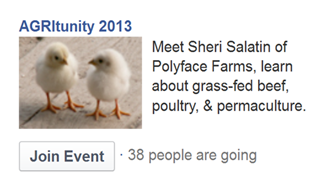
|

|

|
The EcoNomic Living Expo in Orange County was a free day of programming and vendor demonstrations providing adults and youth with information related to sustainability, alternative energy, water quality, Florida-Friendly LandscapingTM, vegetable gardening, financial management, and food preparation. The EcoNomic Living Expo was designed to motivate participants to develop habits that will have a low impact on the environment and to help participants learn how to live healthy and save money.
Facebook marketing was used for the 7th annual AGRItunity Conference and Trade Show in Sumter County to attract a larger and more diverse audience. AGRItunity is an educational event that has evolved over the years into a conference with keynote speakers, breakout sessions, trade show, demonstrations, pre-conference workshops, and farm tours. Extension offices in five counties collaborate to produce the event and focus on providing resources and information to small farmers in Central Florida.
The Florida Nursery Growers and Landscape Association's 2nd annual Plant Geek Bike Ride/Walk/Run in Sumter County was promoted with Facebook marketing to generate interest among the local public about the health and wellness benefits of plants. The Saturday morning event took place in Oakland, Florida, with more than 50 participants.
The Spring Gardening Series in Osceola County consisted of six seminars over a 3-week period. Topics included landscape design, proper plant selection and maintenance, citrus culture, and insect and disease management. One hundred and five (105) residents participated in this series.
Ads promoting individual county Extension pages were run concurrently with ads for the events. In order to purchase the ads, a credit card was attached to the primary administrator's account. The Create Ads option was selected on the Facebook Page. At this point a prompt was given to select the kind of results for the ads. Page Likes was selected for the page ads, and Event Responses was selected for the event ads. The page linked to each event was chosen as the page to be administered. Images were uploaded and inserted into the ad, and the desired text, which was very succinct, was added to create the ad.
The target audience selected for the ads was: from Florida, within 50 miles of the event, all men and women, and ages 30 and up. In general, people in the categories of Gardening, Home/Garden (All), and Health & Wellbeing were targeted. The number of filters was limited to these demographics in order to increase potential reach of the ads. The budget was set at $200 per event for the ad campaign's lifetime. Charges were made to the account based on the number of times an ad was clicked. Each county spent the entire $200 budget allocation per event, and Orange County spent $400 because of Orlando's large population.
Ads were monitored for performance during the campaigns, specifically their Click Through Rates and Frequency. Click Through Rate is the number of unique clicks received divided by the number of times an ad was seen. A Click Through Rate of .10 is good, and.05 is average (M. Sloane, personal communication, September 14, 2012). When Click Through Rates for ads dropped below average, they were re-evaluated for effectiveness.
Frequency was another metric used to analyze ad effectiveness. Frequency is the average number of times a person saw a sponsored story or ad. A frequency of 3 to 4 is considered good (M. Sloane, personal communication, September 14, 2012). When an ad's frequency reaches 8, it is a good strategy to change the ad's picture or do something different because a frequency that high means people were seeing the ad but not responding by clicking it (M. Sloane, personal communication, September 14, 2012).
The success of the each ad was measured by tracking the number of Page Likes for the county's overall Extension Facebook page (which reflects an additional step beyond clicking on the ad to join the event) during a 90-day period. This period included 30 days before each ad started and 30 days after each ended.
Results
First, the overall results of using Facebook advertising to generate new Page Likes are shown for the five advertising periods. Then the percent of new individuals in the "fan" base is reported for each county by age and sex.
Advertising Increased the Fan Base
As shown in Figure 2, the fan base for each county was increasing slowly or not at all prior to the Facebook ad (which began at the time indicated by the green arrow). During the advertisement period, the page "Likes" showed a steady increase. When the ad was discontinued (indicated by the red arrow), changes in the fan base resumed the same pattern (little or no growth) as before the Facebook ad. It is noteworthy that this pattern was consistent across the four counties and the five advertising instances.
The ads generated 213 new Page Likes for the Marion County Extension Facebook page, 372 for Orange County, 150 for Osceola County, and 195 for the combined events in Sumter County. The cost per new Page Like was $.94, $1.08, $1.33, and $2.05, respectively.
Figure 2.
Number of Facebook Page Likes by County for Five Events

Note: Likes are plotted over the period from November 11, 2012 to May 29, 2013.
Advertising Attracts More Fans Who Are Younger
While each Facebook ad led to an increase in the fan base, age and sex were factors that appeared to be associated with the increase. Figures 3 – 6 show the percent of new Page Likes by age group and sex. (Note: Male and Female are abbreviated as 'M' and 'F,' respectively in the figures.) Data showing the distribution of new likes resulting from the Facebook ads suggest that the ads are bringing in a younger demographic of fans. When compared to the distribution of Extension clients in each county (as measured by the most recent data for each county from the annual Florida Cooperative Extension Service's customer satisfaction survey; see Israel, 2013, for an overview of the survey's methods), a greater percentage of new likes was in the younger age categories. For example, in Marion County, 8.4% of Extension clients were males, 65 or older, and another 27.7% were females, 65 and older (Figure 3). In contrast, only .4% and 11.4%, respectively on new Facebook fans were males and females, respectively, in the same age group. It was clear that Facebook ads recruited proportionately younger male and female fans in Marion, Osceola, and Sumter Counties (see Figures 3, 5, and 6). Because Orange County had so many male clients in the 45-54 age category, the benefit of tapping into a younger demographic was less apparent. The Facebook ad did lead to proportionately more females in Orange County.
Figure 3.
Percent of New Likes for the Marion County Master Gardener Spring Festival by Age and Sex in Comparison to Existing Extension Clients
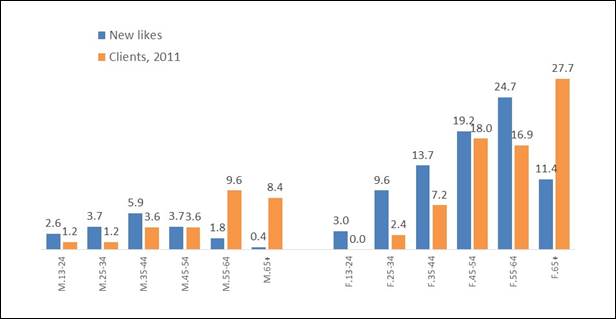
Figure 4.
Percent of New Likes for the Orange County EcoNomic Living Expo by Age and Sex in Comparison to Existing Extension Clients
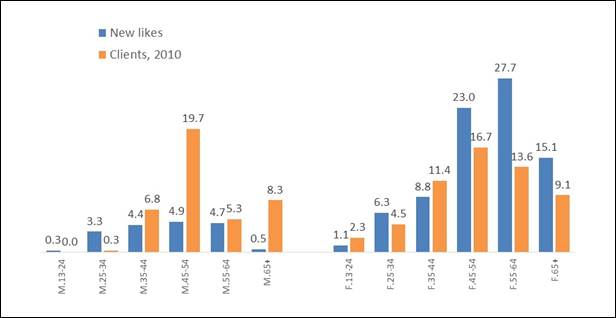
Figure 5.
Percent of New Likes for the Osceola County Gardening in Central Florida Event by Age and Sex in Comparison to Existing Extension Clients
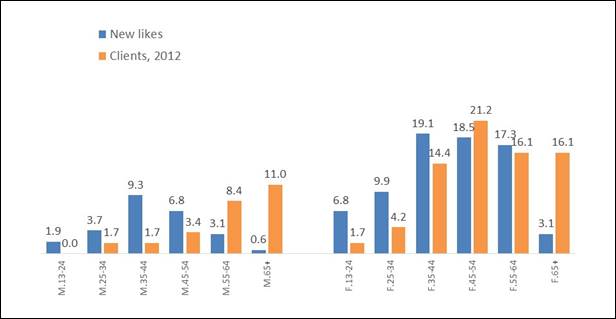
Figure 6.
Percent of New Likes for the Sumter County FNGLA and Sumter County AGRItunity Events by Age and Sex in Comparison to Existing Extension Clients
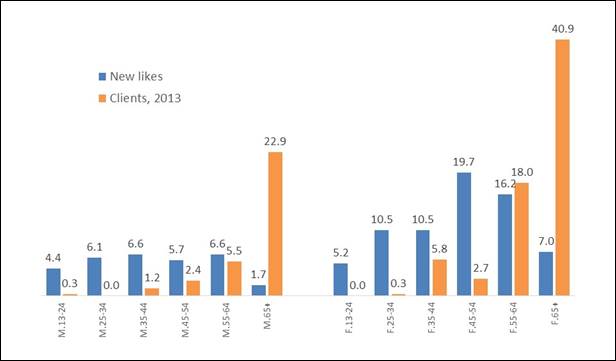
Discussion
Facebook advertising appears to be an effective tool to increase awareness of county Extension Facebook pages, an important social media presence. Advertising a specific event was successful at increasing the number of "Likes" for a Facebook page, as well as getting people to join the event. It should be noted, however, that the increase in the number of likes does not necessarily lead to an increase in actual attendance at the event. In the case of the study reported here, limited evidence from a post-event evaluation in one county revealed that some attendees learned about the event on Facebook, and this suggests that ads can be effective at engaging new clients. There is also some evidence that increasing the fan base (via Page Likes) does, in turn, increase engagement in other electronic media (Martinson et al., 2011).
While Facebook is often perceived as a social media platform specific to a young audience, the demographics suggest that this advertising campaign was successful with almost all age groups. It was clear in three of the four counties that the broader audience target did result in a younger demographic becoming fans of the county Extension Facebook page.
The benefit of expanding the fan base via new "Likes" is that these clients may receive posts from Extension in their newsfeed. Consequently, Extension professionals with more dynamic Facebook pages can "push" more information to clients (Gharis et al., 2014; Kinsey, 2010; Main et al., 2014; Martinson et al., 2011; Typhina et al., 2015). This, in turn, might generate further engagement across Extension's spectrum of programs (Martinson et al., 2011). Since the amount of money required for the month-long ads was small ($200-$400 per county), this suggests that Facebook advertising could prove to be a cost-effective method of advertising. A limitation of the study, however, is the lack of systematic follow-up data to accurately measure other outcomes from the Facebook ad.
Recommendation
Extension professionals should consider investing in Facebook advertising to expand their fan base. These clients can receive more information and help diversify the demographic profile of participants. It will be important to give adequate forethought and preparation to plan a campaign that will reach the desired audience (Gharis et al., 2014).
References
Duggan, M., & Smith, A. (2014). Social media update 2013. Retrieved from: http://pewinternet.org/Reports/2013/Social-Media-Update.aspx. Direct link to the report: http://www.pewinternet.org/files/2013/12/PIP_Social-Networking-2013.pdf
Gharis, L., Bardon, R., Evans, J., Hubbard, W., & Taylor, E. (2014). Expanding the reach of Extension through social media. Journal of Extension [On-line], 52(3) Article 3FEA3. Available at: http://www.joe.org/joe/2014june/a3.php.
Israel, G. D. (2013). Using mixed-mode contacts in client surveys: Getting more bang for your buck. Journal of Extension [On-line], 51(3), Article 3FEA1. Available at: http://www.joe.org/joe/2013june/a1.php
Kapp, J. M., Peters, C., & Oliver, D. P. (2013). Research recruitment using Facebook advertising: Big potential, big challenges. Journal of Cancer Education. 28: 134-137.
Kinsey, J. (2010). Five social media tools for the extension toolbox. Journal of Extension [On-line], 48(5), Article 5TOT7. Available at: http://www.joe.org/joe/2010october/tt7.php
Mains, M., Jenkins-Howard, B., & Stephenson, L. (2013). Effective use of Facebook for extension Professionals. Journal of Extension [On-line], 51(5), Article 5TOT6. Available at: http://www.joe.org/joe/2013october/tt6.php.
Martinson, K., Skelly, C., & Fisher, L. (2011). Measuring the effectiveness of a Facebook fan page for equine Extension programs. Journal of Equine Veterinary Science, 31, 344-345.
Pew Research Center. (2014). Internet use over time. Retrieved from: http://www.pewinternet.org/data-trend/internet-use/internet-use-over-time/.
Telg, R., Irani, T., Hurst, A., & Kistler, M. (2007). Local marketing and promotional efforts of Florida extension agents. Journal of Extension [On-line], 45(2), Article 2FEA5. Available at: http://www.joe.org/joe/2007april/a5.php
Typhina, E., Bardon, R. E., & Gharis, L. W. (2015). Collaborating with your clients using social media & mobile communications. Journal of Extension [On-line], 53(1), Article 1TOT2. Available at: http://www.joe.org/joe/2015february/tt2.php
Waters, R. D., Burnett E., Lamm, A., & Lucas, J. (2009). Engaging stakeholders through social networking: How nonprofit organizations are using Facebook. Public Relations Review 35:102-106.
U.S. Census Bureau. (2013). Florida QuickFacts. Retrieved from: http://quickfacts.census.gov/qfd/states/12000.html.
Vucovich L. A., Gordon, S. V., Mitchell, N., & Ennis, L.A. (2013). Is the time and effort worth it? One library's evaluation of using social networking tools for outreach. Medical Reference Services Quarterly 32(1):12-25.




